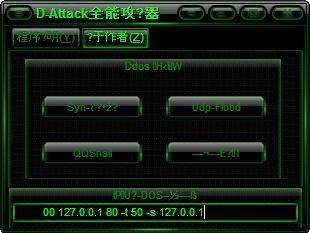HKTL_FLOODER
Windows 2000, Windows Server 2003, Windows XP (32-bit, 64-bit), Windows Vista (32-bit, 64-bit), Windows 7 (32-bit, 64-bit)


Threat Type: Hacking Tool
Destructiveness: No
Encrypted: Yes
In the wild: Yes
OVERVIEW
This hacking tool may be manually installed by a user.
It does not have any propagation routine.
It does not have any backdoor routine.
It does not have any information-stealing capability.
TECHNICAL DETAILS
2,860,568 bytes
EXE
Yes
09 Dec 2013
Drops files
Arrival Details
This hacking tool may be manually installed by a user.
Installation
This hacking tool drops the following file(s)/component(s):
- %Program Files%\syn.exe - detected as HKTL_SYNFLOOD
- %Program Files%\Udp.exe - detected as HKTL_UDPFLOOD
- %Program Files%\Snail.exe - detected as HKTL_QQFLOOD
- %Program Files%\NPS.exe - Non-malicious network monitoring software
(Note: %Program Files% is the default Program Files folder, usually C:\Program Files in Windows 2000, Server 2003, and XP (32-bit), Vista (32-bit), and 7 (32-bit), or C:\Program Files (x86) in Windows XP (64-bit), Vista (64-bit), and 7 (64-bit).)
Propagation
This hacking tool does not have any propagation routine.
Backdoor Routine
This hacking tool does not have any backdoor routine.
Information Theft
This hacking tool does not have any information-stealing capability.
NOTES:
Based on analysis of the codes, it has the following capabilities:
- A user could use this hacking tool to launch any of three request flooding software and/or one network monitoring software by pressing the corresponding button in its interface.
It displays the following images:

It does not have rootkit capabilities.
It does not exploit any vulnerability.
SOLUTION
9.700
1.466.12
13 Dec 2013
Step 1
Before doing any scans, Windows XP, Windows Vista, and Windows 7 users must disable System Restore to allow full scanning of their computers.
Step 2
Remove malware/grayware files dropped/downloaded by HKTL_FLOODER
- HKTL_SYNFLOOD
- HKTL_UDPFLOOD
- HKTL_QQFLOOD
Step 3
Identify and terminate files detected as HKTL_FLOODER
- Windows Task Manager may not display all running processes. In this case, please use a third-party process viewer, preferably Process Explorer, to terminate the malware/grayware/spyware file. You may download the said tool here.
- If the detected file is displayed in either Windows Task Manager or Process Explorer but you cannot delete it, restart your computer in safe mode. To do this, refer to this link for the complete steps.
- If the detected file is not displayed in either Windows Task Manager or Process Explorer, continue doing the next steps.
Step 4
Search and delete this file
- %Program Files%\NPS.exe
Step 5
Scan your computer with your Trend Micro product to delete files detected as HKTL_FLOODER. If the detected files have already been cleaned, deleted, or quarantined by your Trend Micro product, no further step is required. You may opt to simply delete the quarantined files. Please check this Knowledge Base page for more information.
Did this description help? Tell us how we did.

